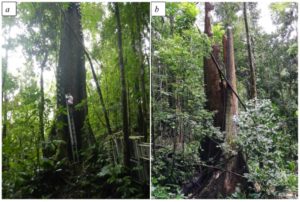
Flores III MR, Aparecido LMT, Miller GR, Moore GW. Assessing Forest Level Response to the Death of a Dominant Tree within a Premontane Tropical Rainforest. Forests. 2021; 12(8):1041. https://doi.org/10.3390/f12081041.
Small-scale treefall gaps are among the most important forms of forest disturbance in tropical forests. These gaps expose surrounding trees to more light, promoting rapid growth of understory plants. However, the effects of such small-scale disturbances on the distribution of plant water use across tree canopy levels are less known. To address this, we explored plant transpiration response to the death of a large emergent tree, Mortoniodendron anisophyllum Standl. & Steyerm (DBH > 220 cm; height ~40 m). Three suppressed, four mid-story, and two subdominant trees were selected within a 50 × 44 m premontane tropical forest plot at the Texas A&M Soltis Center for Research and Education located in Costa Rica. We compared water use rates of the selected trees before (2015) and after (2019) the tree gap using thermal dissipation sap flow sensors. Hemispherical photography indicated a 40% increase in gap fraction as a result of changes in canopy structure after the treefall gap. Micrometeorological differences (e.g., air temperature, relative humidity, and vapor pressure deficit (VPD)) could not explain the observed trends. Rather, light penetration, as measured by sensors within the canopy, increased significantly in 2019. One year after the tree fell, the water usage of trees across all canopy levels increased modestly (15%). Moreover, average water usage by understory trees increased by 36%, possibly as a result of the treefall gap, exceeding even that of overstory trees. These observations suggest the possible reallocation of water use between overstory and understory trees in response to the emergent tree death. With increasing global temperatures and shifting rainfall patterns increasing the likelihood of tree mortality in tropical forests, there is a greater need to enhance our understanding of treefall disturbances that have the potential to redistribute resources within forests.
